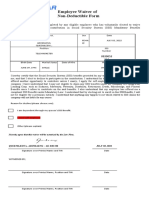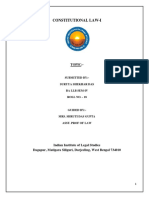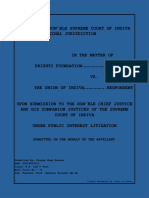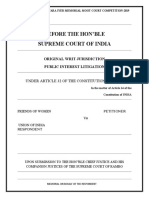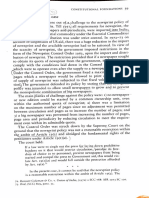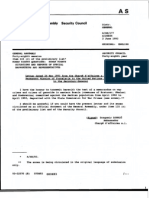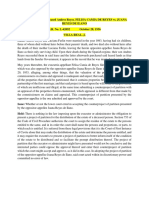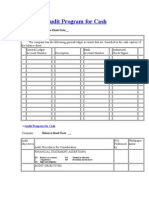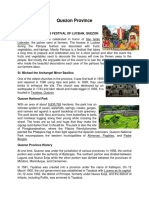Petitioner 1
Petitioner 1
Uploaded by
Abhishek BhandariCopyright:
Available Formats
Petitioner 1
Petitioner 1
Uploaded by
Abhishek BhandariOriginal Title
Copyright
Available Formats
Share this document
Did you find this document useful?
Is this content inappropriate?
Copyright:
Available Formats
Petitioner 1
Petitioner 1
Uploaded by
Abhishek BhandariCopyright:
Available Formats
1
Team Code:
BEFORE THE HONOURABLE SUPREME COURT OF INDIA
IN THE MATTER OF:
NARI MUKTI MORCHA …PETITIONER
Vs.
THE STATE OF MAHAPEKSHA & OTHERS …RESPONDENT
FOR THE KIND ATTENTION OF THE HONOURABLE CHIE JUSTICE AND HIS
COMPANION JUSTICES OF THE SUPREME COURT
MEMORANDUM FOR PETITIONER
2
TABLE OF CONTENTS
INDEX OF AUTHORITIES………………………………………………..
STATEMENT OF JURISDICTION……………………………………….
STATEMENT OF FACTS………………………………………………….
STATEMENT OF ISSUES………………………………………………....
SUMMARY OF ARGUMENTS…………………………………………….
ARGUMENTS ADVANCED………………………………………………..
PRAYER OF RELIEF…….........……………….........................................
MEMORANDUM FOR PETITIONER
3
INDEX OF AUTHORITIES
A. BOOKS REFERRED
● CONSTITUTION
1. D.D. BASU, COMMENTARY ON THE CONSTITUTION OF INDIA, WADHWA, INDIA,
2007, 8TH EDITION, VOLUME I AND II
2. D.D. BASU, CONSTITUTION OF INDIA, LEXIS NEXIS, INDIA, 2009, 8TH EDITION
3. D.D. BASU, SHORTER CONSTITUTION OF INDIA, LEXIS NEXIS, INDIA, 2009, 14TH
EDITION
4. D.D. BASU, HUMAN RIGHTS IN CONSTITUTIONAL LAW, LEXIS NEXIS, INDIA,
2008, 3RD EDITION
5. H.M. SEERVAI, CONSTITUTION LAW OF INDIA, UNIVERSAL PUBLICATIONS,
INDIA, 2004, 4TH EDITION, VOLUME I,II AND III
6. D.J. DE, CONSTITUTION OF INDIA, ASIA LAW HOUSE,INDIA, 2008, 3RD EDITIO
● LAW LEXICONS
1. GARNER, BLACK’S LAW DICTIONARY, THOMAS & WEST, U.S.A, 1990, 9TH
EDITION
B. WEBSITES REFERRED
1. www.scconline.com
2. www.manupatra.com
3. www.supremecourtcases.com
C. CASE LAWS CITED
1. Indra Sawhney v. Union of india, (2000) 1 scc 168: AIR 2000 SC 498.
2. Ramchand Jagdish Chand v. Union of India, AIR 1963 SC 563: (1962) SCR 72.
3. Trimbakeshwar Temple case (Nashik, Maharshtra.)
4. State of West Bengal v. Anwar Ali Sarkar
MEMORANDUM FOR PETITIONER
4
5. Air India Cabin Crewassn v. Yeshawinee Merchant (2003) 6 SCC 277,302:2003 SCC 840.
6. Govt. of Andhra Pradesh v. P.B. Vijayakumar, (1995) 4 SCC 520
7. Mahadeb v Dr B.B.Sen
8. Dattatraya Motiram v State of Bombay
9. Durgah Committee, Ajmer v. Syed Hussain Ali
10. A.K.Gopalan vs State of Madras
11. Maneka Gandhi v. Union of India
12. Kharak Singh v. State of Uttar Pradesh
13. Bandhua Mukti Morcha v. Union of India
14. Puttaswamy v. Union of India
15. Sunil Batra v. Delhi Administration
16. The Commr., Hindu Religious Endowments v. Sri Lakshmindra Thirtha Swamiar of Sri
Shirur Mutt
17. Dr. Noorjehan Safia Niaz and Anr. v. State of Maharashtra and Ors on 26th August, 2016
(Haji Ali Case)
18. Nar Hari Shastri v. Shri Badrinath Temple Committee, AIR 1952 SC 245
19. Jawahar v. Akbar Husain ILR 7 All 178 (FB)
20. V.S. Sivakumar vs State Of Tamil Nadu on 19 March, 2008
21. His Holiness Sri Vishwothama ... vs The State Of Madras on 17August, 1954
22. Venkataramana Devaru v. Statw of Mysore(check)
23. Kalyan Dass vs State Of Tamil Nadu Represented By ... on 5 July,
24. 1972 Equivalent citations: (1972) 2 MLJ 581
25. John Vallamattom v. Union of India
26. Tilak Ram Ram Bux v. State of Punjab and Ors
27. Shani Shinghnapur Case (Maharashtra)
MEMORANDUM FOR PETITIONER
5
STATEMENT OF JURISDICTION
1. The petitioner submits to the jurisdiction of this Hon’ble Court under Art 32 of The
Constitution allows an individual, individual on behalf of public as a whole as well as any
public organisations ie. NGO’s etc to file a PIL or Writ in case of violation of their
fundamental rights guaranteed to citizens of India under The Constitution of India as well as
in cases involving question of right or interest of public, class of people at large.
2. The petitioner submits to the jurisdiction of this Hon’ble Court under Art 32 of The
Constitution of India which gives the Supreme Court original Jurisdiction over disputes
involving public interest at large or having grievance against the State.
3. The jurisdiction of this Hon’ble Court under Art 32 of The Constitution of India is invoked as
there is a violation of Articles 14, 15, 19 (1) (d) and 21
4. The Petitioner submits to the jurisdiction of this Hon’ble Court under The Constitution of
India which allows for the petition to be filed directly to the Hon’ble Supreme Court in case of
violation of fundamental rights of citizens of India
MEMORANDUM FOR PETITIONER
6
STATEMENT OF FACTS
The Rangan Temple which is located in the Peri Tiger Reserve in the Western Ghat mountain
ranges of Pathanam District of Mahapeksha was established in 9th Century by the Hindu
community of Bikhus which is now notified as a scheduled cast, is renowned for lakhs of
pilgrims thronging it all through the year. Pilgrims trek the Jheelimala to reach the shrine,
which has 18 sacred steps, to worship Lord Chinnapa after undergoing strict religious vows
for 48 days.
There is popular folklore surrounding the deity of the God Chinnapa. This folklore states that
Chinnapa, the king of Mahapeksha, was blessed by Lord Mani at the place where this temple
is located, that he would have the power to grant wishes, but provided that he would remain
celibate.
This folklore gave rise to an uninterrupted ban on women entering the temple since 9th
Century. Women aged between 10 to 50, that is those who are in menstruating age, are barred
from entering the temple. While there is no restriction on women to worship the Lord
Chinnapa in any other temple, their entry is prohibited in this temple alone.
The Nari Mukti Morcha (NMM) is a NGO having its headquarters at Thambil which is
located in the neighboring state of Mahapeksha works for the objective of gender equality.
The Nari Mukti Morcha came across an article published in the magazine the vague which
spoke about this practice and tradition of Rangan temple.
The Nari Mukti Morcha was outraged by this and verified the authenticity of this article and
later on got in touch with local woman of Mahapeksha and orchestrated a peaceful rally
against the practice. They agitated for several days but the temple authorities did not open the
doors to women.
As the temple authorities were not heeding to their demands the Nari Mukti Morcha
ultimately moved the Apex court under Article 32 of the Indian constitution against this ban.
MEMORANDUM FOR PETITIONER
7
Though, courts have generally not interfered in the traditions and practices followed in
religious place, it has never failed to uphold equality whenever discrimination was reported.
In this conflict of worshipping rights versus customs, all eyes is now on the Supreme Court of
India.
MEMORANDUM FOR PETITIONER
8
STATEMENT OF ISSUES
I. Whether the present petition is maintainable before the Supreme Court of India?
II. Whether the temple authorities have violated article 14 and article 15 of the constitution
of India?
III. Whether the temple authorities have violated Article 21 of the Constitution of India?
IV. Whether the temple authorities can protect themselves under Article 25 & Article 26 of
the Constitution of India?
MEMORANDUM FOR PETITIONER
9
SUMMARY OF ARGUMENTS
I. Whether the present petition is maintainable before the Supreme Court of India?
Yes, the petitioner submits that the present petition is maintainable in the Supreme Court of
India. There has been an infringement of fundamental rights, human rights, legal rights
guaranteed to all the citizens ie.women between the age of 10-50 under Constitution of India.
It is also a social wrong against the people of Mahapeksha. Therefore, Petitioner being an
NGO, having its headquarters at Thambil whch is located in the neighbouring state of
Mahapeksha working for the objective of gender equality, has sufficient interest in this cause,
thereby having Locus Standi to file this case under Article 32 of the Indian Constitution.
Therefore, the petition filed is maintainable before the Supreme Court of India.
II. Whether the temple authorities have violated article 14 and article 15 of the constitution
of India?
Article 14- “Equality before law The State shall not deny to any person equality before
the law or the equal protection of the laws within the territory of India Prohibition of
discrimination on grounds of religion, race, caste, sex or place of birth.”
The first is a negative concept which ensures that there is no special privilege in favour of any
one, that all are equally subject to the ordinary law of the land and that no person, whatever is
his rank or condition, is above the law.
According to Dr. Jennings, “Equality before the law means that among equals the law should
be equal and should be equally administered, that the like should be treated alike. The right to
sue and be sued, to prosecute and to be prosecuted for the same kind of action should be same
for all citizens of full age and understanding without distinctions of race, religion, wealth,
social status or political influence.”
Equal Protection of the laws does not postulate equal treatment of all persons without
distinction. What it postulates is the application of the same laws alike and without
MEMORANDUM FOR PETITIONER
10
discrimination to all persons similarly situated. In other words, 'Equality among equals'.
In 19th Century, there existed Feudal System in the society. Megna Carta is the first ever
document which recognised human rights in 1912 which was signed by Sir John which led to
the elimination of such a feudal system.
Article 14 of the Constitution is also a human right protected under Article 1 of Universal
Declaration of Human Rights (UDHR) which states that: “All human beings are born free
and equal in dignity and rights. They are endowed with reason and conscience and
should act towards one another in a spirit of brotherhood.”
The same rights are protected under the Constitution as human rights ensured under the
UDHR do not have a binding force over the states.
Therefore, it can be stated that hereby not letting women enter the temple discriminates
between a men and women. Therefore, it is violation of Article 1 of UDHR and Article 14 of
the Constitution of India.
Case Laws:
Indra Sawhney v. Union of india, (2000) 1 scc 168: AIR 2000 SC 498.
The case states that the right to equality is also recognised as one of the basic features of the
Constitution.
In the given case, men and women are treated differently. It also takes away the right of
women between age of 10 to 50 completely treating them differently from the women below
10 years of age and also above 50 years of age. Thus, violating the Article 14 ie. also a
fundamental right under the Constitution India.
Ramchand Jagdish Chand v. Union of India, AIR 1963 SC 563: (1962) SCR 72.
The case states that the person, who pleads that Article 14 has been violated, must make out
that not only he has been treated differently from others, but he has also been treated
MEMORANDUM FOR PETITIONER
11
differently from persons similarly circumstanced without any reasonable biases, and such
differential treatment has been unjustifiable made.
In the given case, women are treated differently from men as well as women who are below
10 years of age and also above 50 years of age. Thus contradicting whatever stated in the
given judgement ie. It treats women differently from the opposite sex and from the women
between below 10 years of age and also above 50 years of age.
Trimbakeshwar Temple case (Nashik, Maharshtra.)
Women were not allowed to enter the inner sanctum of this temple devoted to Lord Shiva till
2016 following which the Bombay High Court in this case passed an order saying that even
even men shouldn’t be allowed to enter the inner sanctum if women are not allowed. Since
then, men have also been barred from entering to maintain gender equality.
Herein, in the given case women between age of 10-50 are barred from entering the temple.
However, men of whatsoever age are allowed to enter the temple. Therefore, it is a gender
inequality. Therefore, either women should be allowed to enter the temple or even the men of
same age group be barred from entering the temple just like women between above stated age
are.
State of West Bengal v. Anwar Ali Sarkar
In this case, the Court rightly observed that the second expression is the corollary of the first
and it is difficult to imagine a situation in which the violation of equal protection of laws will
not be the violation of the equality before the law. Thus, in substance, the two expressions
mean one and the same thing.
Article 15- “Prohibition of discrimination on grounds of religion, race, caste, sex or place
of birth
(1) The State shall not discriminate against any citizen on grounds only of religion, race,
caste, sex, place of birth or any of them.
(2) No citizen shall, on grounds only of religion, race, caste, sex, place of birth or any of
them, be subject to any disability, liability, restriction or condition with regard to
(a) access to shops, public restaurants, hotels and palaces of public entertainment; or
MEMORANDUM FOR PETITIONER
12
(b) the use of wells, tanks, bathing ghats, roads and places of public resort maintained
wholly or partly out of State funds or dedicated to the use of the general public
(3) Nothing in this article shall prevent the State from making any special provision for
women and children
(4) Nothing in this article or in clause ( 2 ) of Article 29 shall prevent the State from
making any special provision for the advancement of any socially and educationally
backward classes of citizens or for the Scheduled Castes and the Scheduled Tribe.”
This section prohibits discrimination on grounds of religion, race, caste, sex or place of birth
among all the citizens of India.
Article 15 of the Constitution is also a human right protected under Article 2 of Universal
Declaration of Human Rights (UDHR) which states that: “Everyone is entitled to all the
rights and freedoms set forth in this Declaration, without distinction of any kind, such as
race, colour, sex, language, religion, political or other opinion, national or social origin,
property, birth or other status. Furthermore, no distinction shall be made on the basis of
the political, jurisdictional or international status of the country or territory to which a
person belongs, whether it be independent, trust, non-self-governing or under any other
limitation of sovereignty.”
Case Laws:
Air India Cabin Crewassn v. Yeshawinee Merchant (2003) 6 SCC 277,302:2003 SCC 840.
In this case, it was stated that however, special provision for women means “that no less
favourable treatment is to be given to women on gender based criterion which would favour
the opposite sex and women will not be deliberately selected for less favourable treatment
because of their sex.’’
Govt. of Andhra Pradesh v. P.B. Vijayakumar, (1995) 4 SCC 520
In this case, it was stated that the state may make Special provisions for women under Section
15(3) of the Constitution to improve women’s participation in all activities under the its
supervision and control of the State can only only in the form of either affirmative action or
reservation.
Mahadeb v Dr B.B.Sen
MEMORANDUM FOR PETITIONER
13
For instance, the Calcutta High Court in this case held, “The impugned law must be shown to
discriminate because of sex alone. If other factors in addition to sex come into play in making
the discriminatory law, then such discrimination does not, in my judgment, come within the
provision of Article 15(1) of the Constitution”.
Dattatraya Motiram v State of Bombay
In Dattatraya Motiram v State of Bombay, the Bombay High Court accepted a form of
discriminatory treatment as constitutionally valid, arguing, “If there is a discrimination in
favour of a particular sex, that discrimination would be permissible provided it is not only on
the ground of sex, or, in other words, the classification on the ground of sex is permissible
provided that classification is the result of other considerations”.It is urged that since all
Devaswoms are Hindu Temples and they are bound to follow the basic tenets of Hindu
religion, individual ill-practice of any temple contrary to the basic tenets of Hindu religion is
impermissible.
The petitioners have pressed into service the decisions of this Court in Sardar Syedna Taher
Saifuddin Saheb v. State of Bombay5, Raja Bira Kishore Deb v. State of Orissa6, Shastri
Yagnapurushadiji v. Muldas Bhundardas Vaishya7 and S.P Mittal v. Union of India8 wherein
the concept of religious denomination was discussed by this Court. It is the stand of the
petitioners that some mere difference in practices carried out at Hindu Temples cannot accord
to them the status of separate religious denominations.
In this case, it was observed by the court that special provisions for protection of women and
children can be made and state can discriminate in favour of women and children but not
discriminate in favour of men against women and children.
In this case, discrimination is made on the basis of sex, age of the women. Therefore, it is
violation of Article 15 of the Constitution guaranteed to every citizen of India
Durgah Committee, Ajmer v. Syed Hussain Ali
The petitioners have also cited the judgment in Durgah Committee, Ajmer v. Syed Hussain
Ali wherein Gajendragadkar, J. clarified that clauses (c) and (d) do not create any new right in
MEMORANDUM FOR PETITIONER
14
favour of religious denominations but only safeguard their rights. Similarly, in matters of
religious affairs, it is observed that the same is also not sacrosanct as there may be many ill-
practices like superstitions which may, in due course of time, become mere accretions to the
basic theme of that religious denomination.
All religions are simply different paths to reach the Universal One. Religion is basically a way
of life to realize one's identity with the Divinity. However, certain dogmas and exclusionary
practices and rituals have resulted in incongruities between the true essence of religion or faith
and its practice that has come to be permeated with patriarchal prejudices.
III. Whether the temple authorities have violated Article 21 of the Constitution of India?
Article 21. Protection of Life And Personal Liberty: No person shall be deprived of his
life or personal liberty except according to procedure established by law.This right is
guaranteed by the constitution.
Article 21 of the Constitution is also a human right protected under Article 3 of Universal
Declaration of Human Rights (UDHR) which states that: “Everyone has the right to life,
liberty and security of person.”
Though the phraseology of Article 21 starts with negative word but the word No has been
used in relation to the word deprived. The object of the fundamental right under Article 21 is
to prevent encroachment upon personal liberty and deprivation of life except according to
procedure established by law. It clearly means that this fundamental right has been provided
against state only. If an act of private individual amounts to encroachment upon the personal
liberty or deprivation of life of other person. Such violation would not fall under the
parameters set for the Article 21. In such a case the remedy for aggrieved person would be
either under Article 226 of the constitution or under general law. But, where an act of private
individual supported by the state infringes the personal liberty or life of another person, the
act will certainly come under the ambit of Article 21. Article 21 of the Constitution deals with
prevention of encroachment upon personal liberty or deprivation of life of a person.
MEMORANDUM FOR PETITIONER
15
The state cannot be defined in a restricted sense. It includes Government Departments,
Legislature, Administration, Local Authorities exercising statutory powers and so on so forth,
but it does not include non-statutory or private bodies having no statutory powers. For
example: company, autonomous body and others. Therefore, the fundamental right guaranteed
under Article 21 relates only to the acts of State or acts under the authority of the State which
are not according to procedure established by law. The main object of Article 21 is that before
a person is deprived of his life or personal liberty by the State, the procedure established by
law must be strictly followed. Right to Life means the right to lead meaningful, complete and
dignified life. It does not have restricted meaning. It is something more than surviving or
animal existence. The meaning of the word life cannot be narrowed down and it will be
available not only to every citizen of the country. As far as Personal Liberty is concerned, it
means freedom from physical restraint of the person by personal incarceration or otherwise
and it includes all the varieties of rights other than those provided under Article 19 of the
Constitution. Procedure established by Law means the law enacted by the State. Deprived has
also wide range of meaning under the Constitution. These ingredients are the soul of this
provision. The fundamental right under Article 21 is one of the most important rights provided
under the Constitution which has been described as heart of fundamental rights by the Apex
Court.
Case Laws:
A.K.Gopalan vs State of Madras
The scope of Article 21 was a bit narrow till 50s as it was held by the Apex Court in this case
that the contents and subject matter of Article 21 and 19 (1) (d) are not identical and they
proceed on total principles. In this case the word deprivation was construed in a narrow sense
and it was held that the deprivation does not restrict upon the right to move freely which came
under Article 19 (1) (d).
Maneka Gandhi v. Union of India
In this case the Supreme Court gave a new dimension to Art. 21 and held that the right to live
the right to live is not merely a physical right but includes within its ambit the right to live
with human dignity.
MEMORANDUM FOR PETITIONER
16
Elaborating the same view, the Court in Francis Coralie v. Union Territory of Delhi],
observed that: “The right to live includes the right to live with human dignity and all that goes
along with it, viz., the bare necessities of life such as adequate nutrition, clothing and shelter
over the head and facilities for reading writing and expressing oneself in diverse forms, freely
moving about and mixing and mingling with fellow human beings and must include the right
to basic necessities the basic necessities of life and also the right to carry on functions and
activities as constitute the bare minimum expression of human self.”
Kharak Singh v. State of Uttar Pradesh
In this case, the Supreme Court quoted and held that:
By the term “life” as here used something more is meant than mere animal existence. The
inhibition against its deprivation extends to all those limbs and faculties by which life is enjoyed.
The provision equally prohibits the mutilation of the body by amputation of an armour leg or the
pulling out of an eye, or the destruction of any other organ of the body through which the soul
communicates with the outer world.
Bandhua Mukti Morcha v. Union of India
Another broad formulation of the theme of life to dignity is to be found in this
case, Characterizing Art. 21 as the heart of fundamental rights, the Court gave it an expanded
interpretation. Bhagwati J. observed:
“It is the fundamental right of everyone in this country… to live with human dignity free
from exploitation. This right to live with human dignity enshrined in Article 21 derives its
life breath from the Directive Principles of State Policy and particularly clauses (e) and (f) of
Article 39 and Articles 41 and 42 and at the least, therefore, it must include protection of the
health and strength of workers, men and women, and of the tender age of children against
abuse, opportunities and facilities for children to develop in a healthy manner and in
conditions of freedom and dignity, educational facilities, just and humane conditions of
work and maternity relief. These are the minimum requirements which must exist in order
to enable a person to live with human dignity and no State neither the Central Government
MEMORANDUM FOR PETITIONER
17
nor any State Government-has the right to take any action which will deprive a person of
the enjoyment of these basic essentials.”
Puttaswamy v. Union of India
Supreme Court in this case held that the right to right to privacy is a fundamental right under
Article 21 of the Constitution of India. Mensuration is one of the things which is natural and
private matter of women ie. related to private organs or changes in her body.
Herein the given case disclosing the identity of menstruating women is a violation of right to
privacy under the Article 21 of the Constitution of India.
Sunil Batra v. Delhi Administration
In this case, the Supreme Court reiterated with the approval the above observations and held
that the “right to life” included the right to lead a healthy life so as to enjoy all faculties of the
human body in their prime conditions. It would even include the right to protection of a
person’s tradition, culture, heritage and all that gives meaning to a man’s life. It includes the
right to live in peace, to sleep in peace and the right to repose and health. Herein, in our case,
section of women are completely restricted from entering the temple hence, restricting them to
enjoy their right to protection of a person’s tradition, culture, heritage and all that gives
meaning to a man’s life.
Herein the given case, the women are physically barred to enter the temple. She is also
restricted to move freely, mixing and mingling with people of her choice just because she is a
women. Therefore, it violates the article 21 which ensures right to life and personnel dignity
of the women.
IV. Whether the temple authorities can protect themselves under article 25 & article 26 of
the constitution of India?
Section 25-“Freedom of conscience and free profession, practice and propagation of religion.
MEMORANDUM FOR PETITIONER
18
This section states that subject to public order, morality and health and to the other
provisions of this Part, all persons are equally entitled to freedom of conscience and the
right freely to profess, practise and propagate religion.”
Article 25 of the Constitution is also a human right protected under Article 18 of Universal
Declaration of Human Rights (UDHR) which states that: “Everyone has the right to freedom of
thought, conscience and religion; this right includes freedom to change his religion or belief,
and freedom, either alone or in community with others and in public or private, to manifest
his religion or belief in teaching, practice, worship and observance.”
Case Laws:
The Commr., Hindu Religious Endowments v. Sri Lakshmindra Thirtha Swamiar of Sri Shirur
Mutt
The word "religion" has been judicially defined by the Supreme Court in this case. The better
known passage of the Supreme Court in the Shirur Mutt case has been quoted in the earlier
judgment. However, an equally explicit definition of religion has been given in paragraphs 14 and
19 of the judgment which are-
"We now come to Article 25 which, as its language indicates, secures to every person, subject to
public order, health and morality, a freedom not only to entertain such religious belief, as may be
approved of by his judgment and conscience, but also to exhibit his belief in such outward acts as
he thinks proper and to propagate or disseminate his ideas for the edification of others."
Dr. Noorjehan Safia Niaz and Anr. v. State of Maharashtra and Ors on 26th August, 2016
(Haji Ali Case)
Bombay High Court held in this case that exclusion of women from the inner sanctum of Haji Ali
Darga by darga trust as illegal and violation of Article 14, 15, and 25 of The Constitution of India.
Nar Hari Shastri v. Shri Badrinath Temple Committee , AIR 1952 SC 245
In this case, the Supreme Court held the right of entering the Temple not a precarious or a
permissive right depending for its existence upon the arbitrary discretion of the temple
authorities, but a legal right in the true sense of the expression. It is a clear pronouncement
MEMORANDUM FOR PETITIONER
19
that the right of worship is a civil one and comes squarely within the cognisance of the civil
courts of the State.
Jawahar v. Akbar Husain ILR 7 All 178 (FB)
In this case, the right to enter a mosque and offer worship irrespective of locality and sect to
which he belongs, is held to be a personal right of every Muslim entitled to be exercised
without hindrance, and affording him "a right of action against anyone who interferes with its
exercise."
V.S. Sivakumar vs State Of Tamil Nadu on 19 March, 2008
Article 25 of the Constitution of India guarantees the citizen of India to practice, propagate
and freely profess any religious order subject to the restrictions contained in the said Article.
Herein in the given case, women are restricted and barred from entering into the temple,
worshipping and offering prayers to the Lord Chinnapa infringing the fundamental right
guaranteed under The Constitution of India under section 25 of the Constitution which ensures
citizens right to freedom of conscience and free profession, practice and propagation of
religion.
Section 26- Freedom to manage religious affairs Subject to public order, morality and
health, every religious denomination or any section thereof shall have the right
(a) to establish and maintain institutions for religious and charitable purposes;
(b) to manage its own affairs in matters of religion;
(c) to own and acquire movable and immovable property; and
(d) to administer such property in accordance with law
Case laws:
His Holiness Sri Vishwothama ... vs The State Of Madras on 17August, 1954
MEMORANDUM FOR PETITIONER
20
In this case, the question that was arosed was about reading Articles 25 and 26 of the Constitution
together and trying to understand the concept of the two articles using harmonious rule of
construction.
However, the question of temple entry is not involved in Article 26(b) but concerned only in
Article 25(2)(b) is clear from the fact that Article 25(2)(b) is an exception to Article 25(1) which
gives fundamental right to any citizen freely to profess practice and propagate his religion. This
freedom of practising religion can be restricted by the Legislature when it infringes with the right
of all classes of Hindus to worship freely in a Hindu religious institution of a public character. it
can have no reference to depriving certain classes or sections of the Hindus of their fundamental
right conferred unequivocally by
Article 25(1) of the Constitution. Articles 26(c) and (d) cannot refer to it. There is no redundancy
between Article 26(b) on the one hand and Articles 26(c) and (d) on the other. Whereas Article
26(b) is wider in its terms Article 26(c) and (d) relate only to movable and immovable properties.
Venkataramana Devaru v. Statw of Mysore(check)
Kalyan Dass vs State Of Tamil Nadu on 5 July,
right is given to non-Hindus
also, to enter into the Hindu temple precincts, which is prohibited under the ancient and
accepted customs annexed to all Hindu temples. The rule violates Articles 25 and 26 of the
Constitution of India and is said to be discriminatory as well, as the mode and manner of worship
at Hindu temples are all matters of religion which are guaranteed by the provisions of the
Constitution of India.
The guarantee under the Constitution of India not only protects the freedom of religious opinion
But it protects also acts done in pursuance of a religion and this is made clear by the use of the
MEMORANDUM FOR PETITIONER
21
expression 'practice of religion' in Article 25.The language of Articles 25 and 26 is
sufficiently clear to enable the Court to determine as to what matters come within the purview of
religion and what do not. Freedom of religion in the Constitution of India is not confined to
religious beliefs only; it extends to religious practices as well as subject to the restrictions which
the Constitution itself has laid down.
John Vallamattom v. Union of India
Article 25 merely protects the freedom to practise rituals, ceremonies, etc. which are an integral
part of a religion as observed by this Court in . While saying so, the Court ruled that a disposition
towards making gift for charitable or religious purpose can be designated as a pious act of a
person, but the same cannot be said to be an integral part of any religion.
Tilak Ram Ram Bux v. State of Punjab and Ors
Again in Lachhman Das on behalf of firm Tilak Ram Ram Bux v. State of Punjab and Ors.,
[1963] 2 S.C.R. 353 @ 374, it has been held that a law applying to one person or one class
of persons is constitutional if there is sufficient basis or reason for it.
In this given case, section of women are barred from enforcing their rights to manage its own
affairs in matters of religion as they are barred from deciding for themselves about their religious
affairs in manner of religion. Such right is taken away by the temple authorities which decides
women’s entry ie. by not allowing them to enter the temple between the age of 10-50.
MEMORANDUM FOR PETITIONER
22
ARGUMENTS ADVANCED
I. Whether there is a violiation of Article 19(d) of The Constitution of India?
Section 19- Protection of certain rights regarding freedom of speech etc
(1) All citizens shall have the right
(a) to freedom of speech and expression;
(b) to assemble peaceably and without arms;
(c) to form associations or unions;
(d) to move freely throughout the territory of India;
(e) to reside and settle in any part of the territory of India; and
(f) omitted
(g) to practise any profession, or to carry on any occupation, trade or business
Yes, it is violation of Article 19(d) as women are not allowed to move into the temple, it being an
integral part ie. within the territory of the India restricting them from these fundamental rights of
citizen of India.
II. Does entry of Women in the temple affects the celibacy nature of Lord Chinappa?
Celibacy is the state of voluntarily being unmarried, sexually abstain, or both, usually for
religious reasons.
Maa Kali, Goddess
Kali comes from the Sanskrit root word Kali which means time. The encyclopaedia Britannic
is grossly mistaken in the following quote “ major Hindu goddess whose iconography, cult,
and mythology commonly associate her with death, sexuality, violence, and paradoxically in
some of her later historical appearances, motherly love.”
It is partly correct to say Kali is a goddess of death but she brings the death of the ego and
kills demons as the illusory self-centred view of reality.
MEMORANDUM FOR PETITIONER
23
Attaching the idea of sexuality however, to Mother Kali has no basis in her at all. There is
nothing that associates her with sexuality in the Hindu stories, any religious granthas or
books. In fact it is just opposite. She is one of the few Goddesses who is celibate practising
austerity and reunication.
However, there is no temple of Maa Kali all over the county of India that restricts the entry of
any men or class of men on the basis of gender. No men are restricted to enter the temple and
worship Maa Kali stating that her celibacy would be affected.
Therefore, celibacy is merely and literally a state of voluntarily/wilfully being unmarried,
sexually abstain, or both, usually for religious reasons and thus entry of women in temple for
the simple reason of worshipping does not affect the celibacy nature of Lord Chinappa.
III. Whether custom will prevail over The Constitutional rights?
No person is above the law and Constitution is supreme in India. Man makes customs and not
visa versa.
Evil practices like Sati pratha, child marriage, dowry, etc were also customs that people
followed since years however; they were abolished later on as it was unconstitutional and
illegal. It was abolished through the acts by Parliaments such as Sati Prohibition Act, Dowry
Proection Act , IPC, etc. Therefore, customs do not prevail over the Constitution of India.
Hence, the custom followed in the Chinappa temple should not be followed as it is
unconstitutional.
Case laws-
Shani Shinghnapur Case (Maharashtra)
In this case, Bombay High Court permitted women to enter the temple and pray in sanctum
sanctorum putting an end to a 400 year custom and made it clear to the state that it was
incumbent upon them to ensure that the Maharashtra Hindu Places of Worship (Entry
Authorisation Act, 1956 was properly enforced.
Hence, in this case women should not be barred from entering the temple on the ground of
customs.
MEMORANDUM FOR PETITIONER
24
PRAYER
In light of the legal precedents and principles cited; and in light of the provisions of the
Constitution applied and arguments advanced; and in light of the scientific studies relating to
the issue referred to, the Petitioners most humbly prays that the Supreme Court:
1. Hold that the petition filed by the NMM is maintainable under Art 32 in the Supreme Court of
India.
2. To allow and help women to enter in the Chinappa temple and protect their religious rights in
equality with the men ie. without any kind of discrimination and differentiation amongst the
citizens of India.
3. Ensure the Fundamental Rights of women guaranteed to them being citizen of India.
4. To provide with any other the remedy as the Hon’ble Court may deem fit and proper.
5. Declare Hindu Religious and Charitable Endowments Act as being ultra vires to the
Constitution of India, violating Art 14,15 & 21.
6. Issue a writ of mandamus directing the State Government.
At this point, it is important to highlight that the practice of most of these menstrual restrictions have been
given up by the current generation, though many of them still practice few of the restrictions, especially
those related to religious practices. According to a study by Dr. Jasmine Gujarathi, Dr. Dilip Jani and Dr.
ARV Murthy [2], which interviewed girls from urban and rural background, noted that out of 798 girls
interviewed, only 14.16% followed restriction on cooking. Similarly, restriction on touching others, sleeping
on same bed, and on applying turmeric and kajal were followed by 10.90%, 5.89%, and just 2.38% of girls
respectively. Adherence to menstrual restrictions was highest with respect to religious practices like not
MEMORANDUM FOR PETITIONER
25
participating in religious activity (41.60%) and not visiting temple (47.62%). Only 25 girls (3.13%) said that
they did not follow any restriction.
The study is very insightful, because it reveals that almost half of the interviewed girls followed menstrual
restrictions with respect to religious practice, but mostly ignored others, especially those given in Ayurvedic
Paricharya. This is significant, because it denotes that somewhere down the line, people forgot the health
principles, which are as important a guiding principle behind various tenets of menstrual Do’s and Don’ts, as
the religious and spiritual principles are. This is further reinforced by the fact that out of 676 girls, who
answered the question about why they followed some of the restrictions, 39.50% girls selected ‘culture’ as
the reason and 44.53% selected ‘religion’ as the reason.
The study also revealed that out of 583 girls, who answered the question why they no longer follow
restrictions all the time, 24.70% of them said it was due to exposure to new modern culture, whereas 38.25%
said it was because these restrictions are no longer practical in today’s time. The current generation has
become disconnected from Indian traditions, and as “ritual observance” is disparaged, the guiding principles
behind menstrual practices–be it the religious principles of Ashaucha, austerity, self-purification, and
celebration, or the health principles enunciated in the Ayurvedic texts—need to be articulated.
Unfortunately, the elder generation itself is often ignorant about the Hindu notion of menstruation and the
principles that guide various menstruation practices.
Are these restrictions is practical in today’s fast moving society? The present globalized society with its fast
life pose serious obstacles to the traditional way of life. Women may find it very difficult to strictly follow
all the restrictions all the time. But, contemporary women also struggle with menstrual difficulties. The
practices need to be seen not as “oppressive restrictions” being imposed on them, but rather as
therapeutic prescriptions. As the study [3] by Dr. Pallavi Pai, Dr. Sarita Bhutada, and Dr. Prasad Pandkar,
shows, with little effort, women naturally increased observance of the restrictions as they practiced them and
experienced the benefits. The study, which was earlier quoted in the article on “Menstruation in Ayurveda”,
shows that the compliancy to various menstruation restrictions among the 30 unmarried woman, who were
monitored, increased from an average of 76.10% at the beginning to 86.66% towards the end of the study
period. This clearly shows that, when seen as natural, alternative therapy and part of a spiritual practice,
women may choose to practice many, if not all, of the menstrual restrictions during their monthly periods.
This practice of even few tenets of the menstruation Do’s and Don’ts can be highly beneficial. As Lord
Krishna in Bhagavad Gita (2.40) says “Even a little practice of Dharma saves one from great fear.”
MEMORANDUM FOR PETITIONER
26
What was followed as ritual in the past, needs to be grounded in scientific reason and experience in this age.
The Western lens of “religion” and “superstition” distorts our understanding of the scientific basis for these
rituals. More important than strict adherence to each and every prescription is the inner awareness
that menstruation is an austerity, a self-purifying process and the recognition that menstruation
practices have been designed for the overall welfare of women. Thus, developing a correct and a positive
outlook towards menstruation is as important as practicing them. With the proper understanding, practice
will arise more naturally in our times.
MEMORANDUM FOR PETITIONER
You might also like
- Get (Ebook PDF) Canadian Politics Today: Democracy, Diversity and Good Government, 1st Edition Free All ChaptersDocument43 pagesGet (Ebook PDF) Canadian Politics Today: Democracy, Diversity and Good Government, 1st Edition Free All Chaptersbitijezaqro100% (7)
- Waiver For Non-Deductible FormDocument2 pagesWaiver For Non-Deductible FormQueenileen Arindaeng80% (10)
- Memorial (Appellant) 1Document19 pagesMemorial (Appellant) 1Shibanee acharya100% (1)
- Sujit Kumar, Moot Memorial On Triple Talaq, Nikah Halala, PolygamyDocument25 pagesSujit Kumar, Moot Memorial On Triple Talaq, Nikah Halala, PolygamySujit Kumar100% (3)
- 1st Shri Nirmala Devi Bam Respondent SideDocument17 pages1st Shri Nirmala Devi Bam Respondent Sideuttkarsh singhNo ratings yet
- Moot MemorialDocument18 pagesMoot MemorialLawcabularyNo ratings yet
- Kes'S Jayantilal H. Patel Intra Collegiate Moot Court CompetitionDocument33 pagesKes'S Jayantilal H. Patel Intra Collegiate Moot Court CompetitionKomal JajooNo ratings yet
- MootDocument17 pagesMootAksh Aggarwal50% (2)
- AdvancedDocument22 pagesAdvancedUditanshu MisraNo ratings yet
- Moot March RespondentDocument16 pagesMoot March RespondentNavinNo ratings yet
- 0 - Final Respondent Memo2021Document35 pages0 - Final Respondent Memo2021Mehak RakhechaNo ratings yet
- The Ahmedabad St. Xaviers College Society & Anr. Etc.Document16 pagesThe Ahmedabad St. Xaviers College Society & Anr. Etc.Amit RajNo ratings yet
- NotesDocument16 pagesNotesPiku NaikNo ratings yet
- Mukund Moot CourtDocument23 pagesMukund Moot Courtabhishekvarma077No ratings yet
- Moot Memorial On Triple Talaq Nikah Halala PolygamyDocument27 pagesMoot Memorial On Triple Talaq Nikah Halala Polygamykcpartners legalNo ratings yet
- NotesDocument20 pagesNotesPiku NaikNo ratings yet
- Petitioner FinalDocument20 pagesPetitioner FinalAdv AAkanksha ChopraNo ratings yet
- Moot Court 1Document11 pagesMoot Court 1Piku NaikNo ratings yet
- Memorandum Petitioner Moot 2Document26 pagesMemorandum Petitioner Moot 2baluNo ratings yet
- Moot SubmissionDocument16 pagesMoot SubmissionAayushman SharmaNo ratings yet
- junaid moot file 16 newDocument14 pagesjunaid moot file 16 newdanishnazir01111No ratings yet
- Petitioner Moot CourtDocument13 pagesPetitioner Moot Courtmanishrekha26No ratings yet
- PETITIONERS MemorialDocument19 pagesPETITIONERS MemorialChushmachowdary GollaNo ratings yet
- Petitioner Side PDFDocument22 pagesPetitioner Side PDFMoveonNo ratings yet
- Judiciary and Human RightsDocument7 pagesJudiciary and Human Rightsharudas1800No ratings yet
- Epistolary JurisdictionDocument3 pagesEpistolary Jurisdiction22010323067No ratings yet
- Moot Memo PrayagDocument25 pagesMoot Memo PrayaganxietysprenNo ratings yet
- MAHAK GUPTA (Assignment No.2)Document15 pagesMAHAK GUPTA (Assignment No.2)Anjali LakhwaniNo ratings yet
- Right To Speedy Trial Petitioner MemorialDocument14 pagesRight To Speedy Trial Petitioner MemorialSouvik ChakrabortyNo ratings yet
- MootDocument22 pagesMootAalok SusmithaNo ratings yet
- Mabijs Moot Court 2020 ApplentDocument27 pagesMabijs Moot Court 2020 ApplentThe VIKARINo ratings yet
- PetitionerDocument16 pagesPetitionerShanthini sivakumarNo ratings yet
- Final 1st Moot Court - Memorial (Petitioner)Document20 pagesFinal 1st Moot Court - Memorial (Petitioner)simranNo ratings yet
- Moot Preparation StartDocument20 pagesMoot Preparation Startvinodhini aNo ratings yet
- Suhail Moot CourtDocument16 pagesSuhail Moot CourtJer RyNo ratings yet
- RespondentDocument18 pagesRespondentShanthini sivakumarNo ratings yet
- PetitionerDocument14 pagesPetitionertriptii100% (1)
- Moot MemorialDocument19 pagesMoot MemorialHencie Patel0% (1)
- Submissions On Behalf of PetitionerDocument17 pagesSubmissions On Behalf of PetitionerHarshith GowdaNo ratings yet
- Moot MemorialDocument27 pagesMoot MemorialSadiqNo ratings yet
- TC-04 (P)Document24 pagesTC-04 (P)utsavNo ratings yet
- Case Commentary - InternshipDocument9 pagesCase Commentary - InternshipPrabhav PandeyNo ratings yet
- Mehnaaz - Moot CourtDocument13 pagesMehnaaz - Moot CourtHindustani BhauNo ratings yet
- Moot Memorial PetitionerDocument16 pagesMoot Memorial PetitionerShweta NisarNo ratings yet
- TC161PDocument18 pagesTC161Pdupg0046106No ratings yet
- NLS04-PDocument27 pagesNLS04-PPrakash SinghNo ratings yet
- Sabarimal Case Memorial For Petitioner - CompressDocument23 pagesSabarimal Case Memorial For Petitioner - Compressmaddy masonNo ratings yet
- Caselaws Ppt LlDocument31 pagesCaselaws Ppt Llanimeverse0430No ratings yet
- Bharata Mata School of Legal Studies - Moot Court 2019 Before The Hon'Ble Supreme CourtDocument43 pagesBharata Mata School of Legal Studies - Moot Court 2019 Before The Hon'Ble Supreme Courtveer vikramNo ratings yet
- PetitionerDocument13 pagesPetitionerSubhadra ChhabraNo ratings yet
- Memorial On Behalf of The RespondentDocument10 pagesMemorial On Behalf of The RespondentAditya AnandNo ratings yet
- Winner ADocument28 pagesWinner AHima ReddyNo ratings yet
- Before The Hon'Ble Supreme Court of India: Original Writ Jurisdiction Public Interest LitigationDocument13 pagesBefore The Hon'Ble Supreme Court of India: Original Writ Jurisdiction Public Interest LitigationBipin RethinNo ratings yet
- Tan HarDocument15 pagesTan HarBrijeshNo ratings yet
- Before The Hon'Ble Supreme Court of Sindhia: Team CodeDocument33 pagesBefore The Hon'Ble Supreme Court of Sindhia: Team CodeThiru The PranksterNo ratings yet
- Case Comment SP Mittal Vs Union of IndiaDocument5 pagesCase Comment SP Mittal Vs Union of IndiaShashank Shri TripathiNo ratings yet
- University Institute of Legal Studies Panjab University, ChandigarhDocument18 pagesUniversity Institute of Legal Studies Panjab University, Chandigarhfizunofficial7No ratings yet
- NLS04-RDocument24 pagesNLS04-RPrakash SinghNo ratings yet
- Final MemoDocument18 pagesFinal Memokcpartners legalNo ratings yet
- Moot Memorial (Petitioner) - Essential Religious Practices (ERP)Document23 pagesMoot Memorial (Petitioner) - Essential Religious Practices (ERP)Kunal ShekharNo ratings yet
- JE3 TestDocument6 pagesJE3 TestQwerty BoardNo ratings yet
- It’s Time to Implement the Forgotten Constitution of India for Liberty and DignityFrom EverandIt’s Time to Implement the Forgotten Constitution of India for Liberty and DignityRating: 3 out of 5 stars3/5 (2)
- Lea 101Document2 pagesLea 101Melissa MacamNo ratings yet
- Instructions For Architects and Engineers: Division of Engineering and Architectural ServicesDocument90 pagesInstructions For Architects and Engineers: Division of Engineering and Architectural ServicesRavi ChandraNo ratings yet
- John Deere 914p Belt Pickup With Platform Parts CatalogDocument5 pagesJohn Deere 914p Belt Pickup With Platform Parts Catalogida100% (65)
- Telephonic Statement of Ian JohnsonDocument67 pagesTelephonic Statement of Ian JohnsonOG.NRNo ratings yet
- Img 20231017 0003Document6 pagesImg 20231017 0003viratforwardersNo ratings yet
- Emergency and Press CensorshipDocument12 pagesEmergency and Press CensorshipHunaynah ShaikhNo ratings yet
- Motion For Production of DocumentsDocument2 pagesMotion For Production of DocumentsJoemar CalunaNo ratings yet
- Serbian Witness Statements I - Srebrenica Report 1994 AddendumDocument27 pagesSerbian Witness Statements I - Srebrenica Report 1994 AddendumkrcaNo ratings yet
- Unit 3Document9 pagesUnit 3danish akhtarNo ratings yet
- GR 182737Document1 pageGR 182737carlo dumlaoNo ratings yet
- In Re Estate of The Deceased Andres ReyesDocument1 pageIn Re Estate of The Deceased Andres ReyesJurico AlonzoNo ratings yet
- ResultDocument10 pagesResultArko PrakashNo ratings yet
- Fathers DayDocument3 pagesFathers DayJohni S. PasaribuNo ratings yet
- Partition AllahdadDocument6 pagesPartition Allahdadtaimoor waheed MalikNo ratings yet
- Once A Mortgage Always A MortgageDocument4 pagesOnce A Mortgage Always A MortgageRupeshPandya100% (2)
- SOC Selected Optimized Coordination Coordination Table For Motor ProtectionDocument21 pagesSOC Selected Optimized Coordination Coordination Table For Motor ProtectionShuaib MuazzamNo ratings yet
- 2022 LHC 7112Document4 pages2022 LHC 7112hosneara ChobiNo ratings yet
- PMR FormDocument2 pagesPMR FormMa.angela Vaneza MendozaNo ratings yet
- Lecture On CDI 2 Chapter 1Document57 pagesLecture On CDI 2 Chapter 1jhared202020No ratings yet
- Cash ProgramDocument13 pagesCash Programapi-3828505No ratings yet
- Glossary of Political GeographyDocument144 pagesGlossary of Political GeographyAngelo AlbanNo ratings yet
- Nazism and Rise of Hitler Question and AnswersDocument6 pagesNazism and Rise of Hitler Question and AnswersJapgun KaurNo ratings yet
- Eyecite: A Tool For Parsing Legal Citations: Jack Cushman, Matthew Dahl, and Michael LissnerDocument4 pagesEyecite: A Tool For Parsing Legal Citations: Jack Cushman, Matthew Dahl, and Michael LissnerffffNo ratings yet
- History and Facts in Quezon Prov MemawDocument3 pagesHistory and Facts in Quezon Prov MemawveloNo ratings yet
- Anabo at 09453063427 or Reinald Panganiban at 09989899564Document3 pagesAnabo at 09453063427 or Reinald Panganiban at 09989899564Clifford Dwight RicanorNo ratings yet
- Son of DavidDocument1 pageSon of Davidch9ck4jj7vNo ratings yet
- Corporate Laws II Syllabus - 07.03.2018Document12 pagesCorporate Laws II Syllabus - 07.03.2018Pavithra MurugesanNo ratings yet
- Foco Refundable ShahjahanpurDocument20 pagesFoco Refundable ShahjahanpurMANOJNo ratings yet

